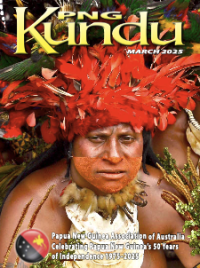The Okapa pine forest: Alan Ross
The year I undertook a reconnaissance of the Jimi Valley pine stands in the Western Highlands District (see here) saw me as well in the eastern extremities of the Highlands. In the months of June and July 1957 a survey of the Okapa pine forest was carried out. Situated in the Forei (or Fore) area in the then Kainantu Sub-district of the Eastern Highlands District and some 66 kilometres southeast of the township of Kainantu, the Araucaria pine forest in question was of interest to the Department of Forests as a back-up source of seed supply for the large reforestation program—plantings of Hoop pine and Klinki pine to replace the natural pines that were being harvested for conversion to veneer and plywood at the Bulolo plymill—that was in progress in the Wau-Bulolo Valleys of the Morobe District. My work party numbering about eight from the Bulolo forest station and I carried out a forest inventory and a boundary survey of the forest area as a prelude to a timber rights purchase (TRP) should the local landowners be willing to transfer those rights to the Government.
But first there was a call on the Okapa patrol post located near Moke village on a ridge top some six kilometres above and northwest of the Okapa guest house. I had heard that the patrol officer who established the patrol post was instructed to site the station at Okapa, which was rather a transient centre and less a village site at the time. But deciding that Moke was a better location—the right decision one would think—the sensible but perhaps audacious patrol officer sited the patrol post at Moke and named it Okapa. Neat!
The officer-in-charge of the patrol post at the time of my visit was the affable Jack Baker. The visit coincided with early days into the investigations of a mysterious brain disease locally known as kuru and mortally affecting some five percent of the Forei population. In residence were Vincent Zigas, the district medical officer from Kainantu, Carleton Gajdusek, a virologist and paediatrician from Yonkers, New York State, USA, and Lois Larkin (later to wed Baker) a technician from the Walter and Eliza Hall Institute in Melbourne, Australia. Kuru was called the laughing death (those inflicted had fits of maniacal laughter and giggling) but it was no laughing matter as it brought about a certain, early and unpleasant death. Gajdusek showed me over the nearby hospital for kuru patients: he pointed out a lad of about nine or ten whose head was constantly shaking, an early symptom of kuru. He said the poor kid would be deceased in about six months.
A story current at the time was that people staying at the patrol post’s guest house would dine at one end of the table while parts of deceased kuru patients were being dissected by the doctors at the other end of the same table. I can vouch for the authenticity of the tale. The evening I dined at the guest house Messrs Gajdusek and Zigas shared the same table as they went about their business of carving up brains and other body parts for dispatch to overseas laboratories for examination.
The rest house at Okapa, where the road for four-wheel drive vehicles terminated, was run down, dark inside and in need of repair, so my work party and I set up tents and tarpaulins nearby. It was only a short walk—perhaps up to thirty minutes—along a good walking track atop a grassy ridge from the rest house to the edge of the forest. One early morning as we were setting out to work, men from the nearly village of Abomatasa popped up near us out of nowhere it seemed holding bows and arrows and other sharp instruments. With hardly a cursory “good morning” they swept past us: they were in hot pursuit of a wild pig.
There are reasons to believe that the Okapa Hoop pine forest of some 1,020 hectares is the remnant of a larger pine stand. The forest is surrounded completely by grassland caused by the local people carrying out shifting cultivation and burning off (so-called “slash and burn” agriculture), but looking south towards the Lamari River one could see isolated pockets of pine trees growing in gullies and above the grassline, which suggested the original forest in that region contained significant pine stands before people settled the area and began cultivating the land.
A tree and volume count of the Okapa forest along four strip lines cut diagonally across the main watercourse (Agomati Creek) revealed dense and vigorous pine stands in certain places, with abundant regeneration. The hardwoods on the whole were disappointing, few merchantable species, and mostly small sized trees with boles of pole size.
As stated earlier, a boundary survey was carried out for a possible TRP. When the local landowners were approached on the matter they were not in agreement. So the idea for a TRP lapsed. Some small seed collections took place intermittently on a cash payment basis, while it is understood at a later time some pine trees were harvested and converted to sawn timber and flitches for the local market, again on a cash payment basis.
As pine seed became more readily available in the Bulolo vicinity and other localities, the need for the Okapa forest as a back-up seed source declined.



